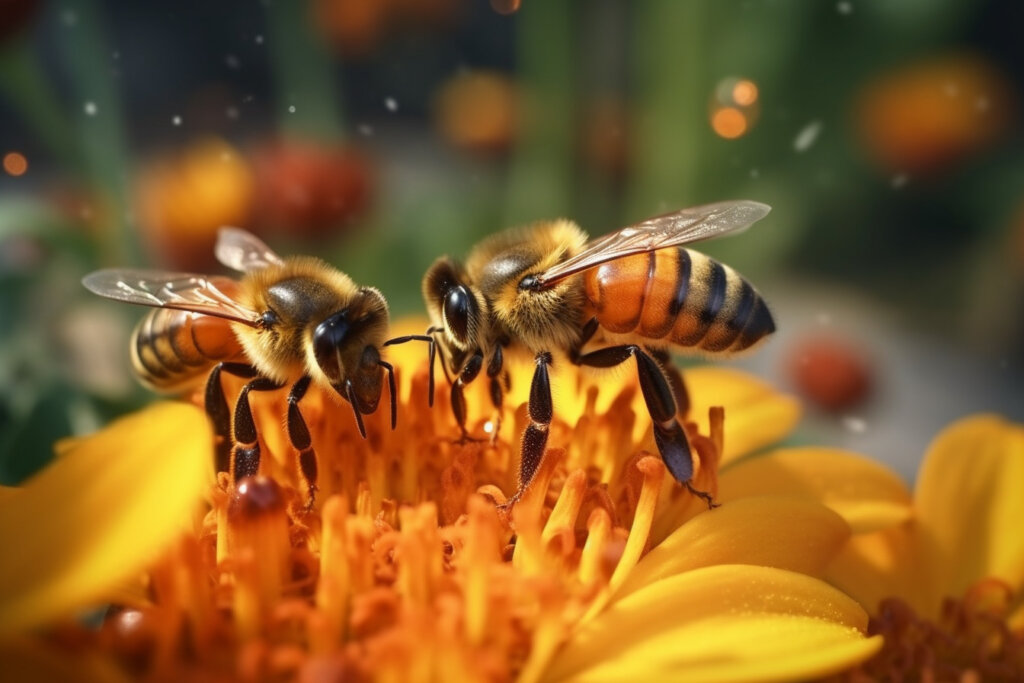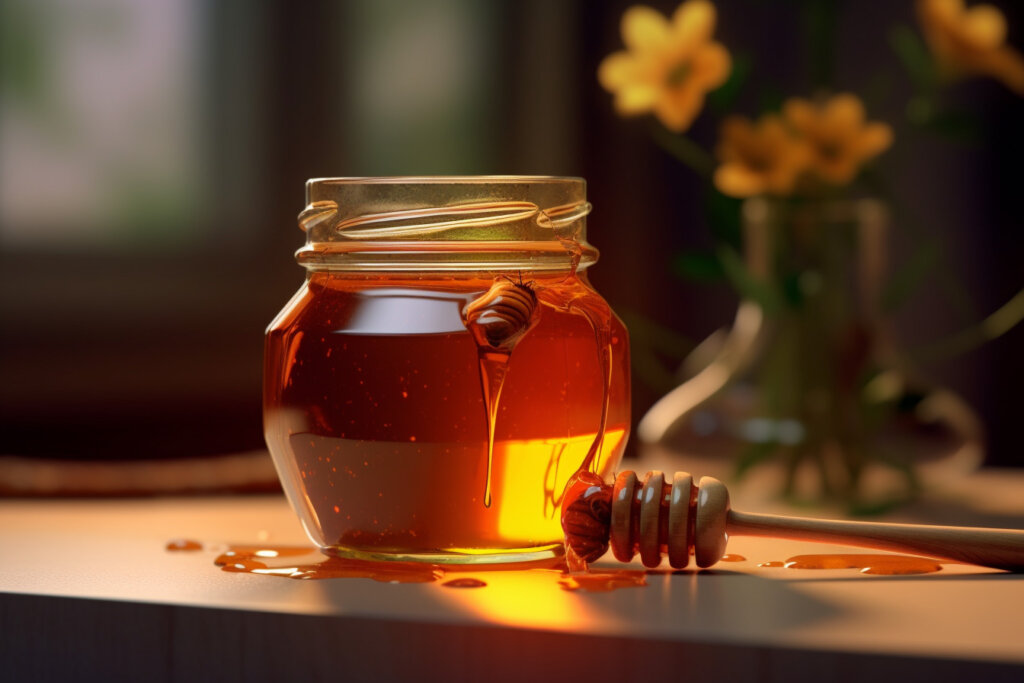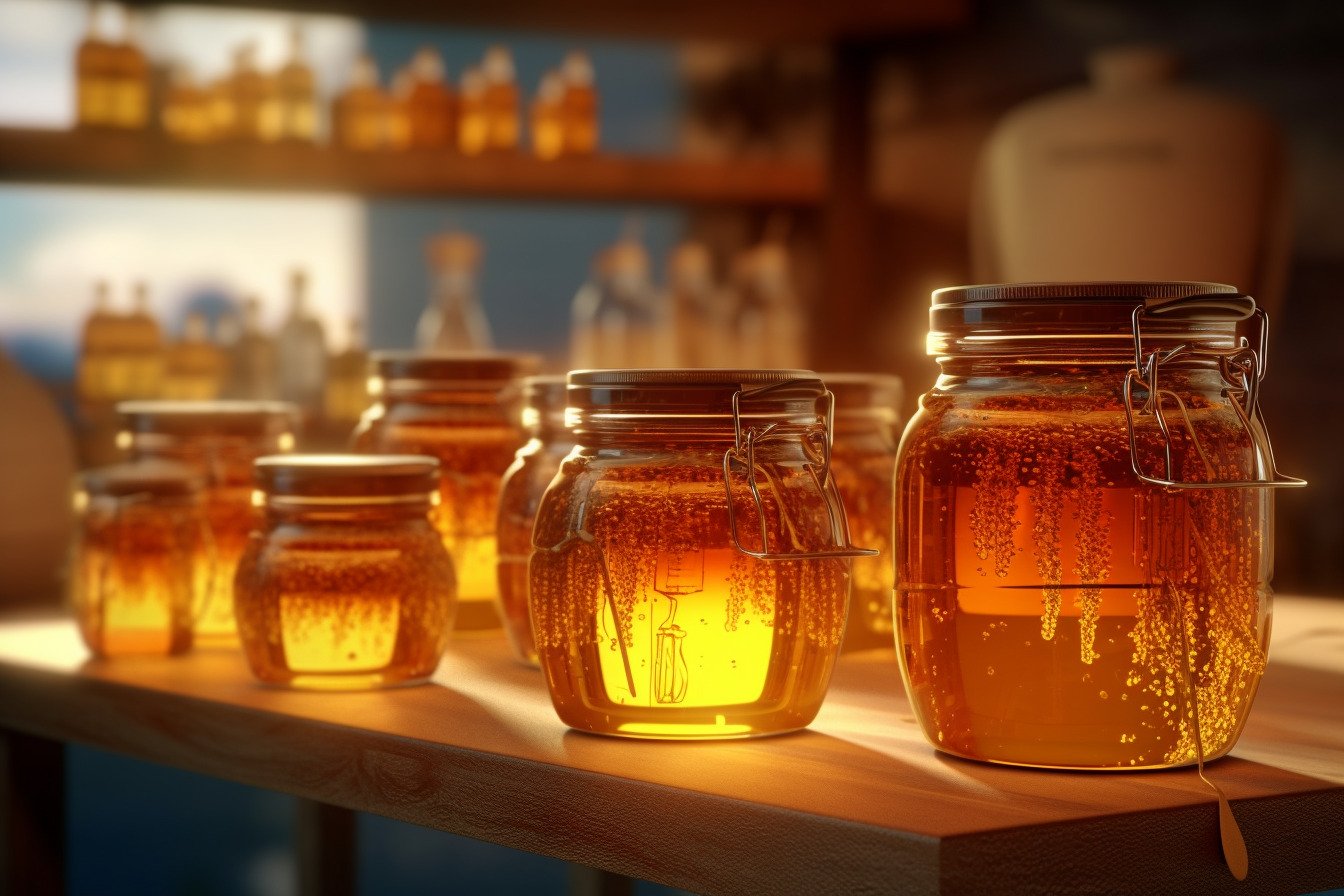Brief Overview of the Topic
Honey – the sweet, golden liquid that is often dubbed as nature’s liquid gold. Produced by diligent honey bees, this natural sweetener has been cherished by humans for thousands of years, not just for its delightful taste but also for its numerous nutritional and medicinal properties. Honey is a complex blend of natural sugars, water, minerals, vitamins, pollen, protein, and other substances. In human consumption, it serves as a healthier alternative to sugar, an energy booster, and a key ingredient in a myriad of culinary applications across cultures. From a scientific perspective, the process of honey production is an intriguing marvel of nature.
Role of Bees in Honey Production
Bees play an absolutely essential role in the production of honey. This complex process is carried out primarily by a species of bee known as the Apis Mellifera, or more commonly, the honey bee. These industrious insects work in a highly organized, cooperative manner within their colonies, which consist of a single queen, a few hundred drones, and tens of thousands of worker bees. Each plays a specific role in the intricate process of honey production. Worker bees, in particular, are the ones most actively involved in nectar collection, conversion into honey, and storage. The honey production process is not just a fascinating biological phenomenon, but it also serves as a testament to the remarkable efficiency and productivity of honey bees.
In the following sections, we will delve deeper into this sweet process and explore the step-by-step journey that transforms nectar into the delectable honey we all relish.
The Life of a Honey Bee
Understanding Bee Hierarchy
Bee societies are among the most structured and hierarchical in the animal kingdom. They are typically composed of three types of bees: the queen, the drones, and the worker bees. Each of these types has a unique role to play within the colony.
The queen bee is the single reproductive female in the colony and mother to all other bees within the hive. Her primary role is to lay eggs – up to 2000 per day during peak season – thus ensuring the survival and growth of the colony.
Drones, which are the male bees, have just one purpose – to mate with the queen. They are larger and more robust than worker bees, but their lifespan is quite short. After mating, which is their only function, drones die.
The most numerous members of the colony are the worker bees, which are non-reproductive females. They perform virtually all the tasks necessary for the colony’s survival, such as foraging for food, building and repairing the hive, protecting the colony, and of course, making honey.
The Role of Worker Bees
The process of honey production primarily rests on the tiny shoulders of worker bees. Their work begins in the field, where they flit from flower to flower, collecting nectar, a sugary liquid produced by flowers. They store this nectar in their ‘honey stomachs’, a separate compartment from their actual stomach, designed specifically for this purpose.
Once their honey stomachs are full, worker bees return to the hive, where they regurgitate the nectar to house bees. These house bees further process the nectar by adding enzymes and reducing its water content. They then deposit the transformed nectar into the honeycomb cells, where it eventually becomes honey through a process of evaporation.
Even after the honey is produced, the worker bees’ job is not done. They are also responsible for capping the honey-filled cells with beeswax, thus preserving the honey for future consumption. This elaborate division of labor among worker bees is key to their efficiency and productivity in honey production.
Flower Visitation and Nectar Collection

How Bees Choose Flowers
When it comes to selecting flowers for nectar collection, bees are remarkably adept. Their choice of flowers is influenced by several factors including the type of flower, its color, scent, and the quality and quantity of nectar it produces.
Bees have a preference for certain types of flowers over others, with a bias towards those that produce high volumes of nectar with an adequate sugar concentration. Color plays a significant role as well. Bees tend to be attracted to bright colors like blue, purple, yellow, and white.
The scent of the flower is also a crucial factor. Bees have an extraordinary sense of smell, allowing them to detect flowers with high nectar content from a distance. Some flowers even release specific chemical signals, known as pheromones, that attract bees.
The Process of Nectar Collection
Once a suitable flower has been located, the bee lands on the flower and uses its long, straw-like tongue known as a proboscis to reach into the flower and draw out the nectar. This nectar is then stored in a special part of the bee’s stomach known as the “honey stomach” or “crop”, designed specifically for nectar storage.
During nectar collection, pollen from the flower’s anthers often sticks to the bee’s body. As the bee moves from flower to flower, some of this pollen rubs off on the pistils of the subsequent flowers, thus facilitating pollination. This unintentional act of cross-pollination is crucial for the survival and reproduction of many flowering plants and showcases the importance of bees within our ecosystems.
The bee continues to collect nectar until its honey stomach is full, at which point it returns to the hive to unload its precious cargo and repeat the whole process. One bee’s nectar collection, though a small contribution, is a vital piece of the honey-making puzzle.
Conversion of Nectar into Honey
Nectar Digestion
The journey of nectar’s transformation into honey begins when the forager bee returns to the hive. The nectar, still stored in the forager’s honey stomach, is regurgitated and passed on to a younger house bee.
During this transfer, the nectar mixes with the house bee’s saliva, which contains a unique enzyme called invertase. This enzyme breaks down the complex sugars in the nectar into simpler ones, primarily glucose and fructose, making it more digestible and less prone to crystallization. This is a crucial step in the transformation of nectar into honey.
In addition to the enzymatic conversion, part of the water in the nectar is also evaporated, which is the first step towards concentrating the nectar into a thicker syrup.
Regurgitation and Storage
After partial digestion, the nectar-saliva mixture is then regurgitated by the house bee into a cell of the honeycomb. It is not yet honey, but a sweet liquid known as “bee bread.” The process of regurgitation and storage in the honeycomb cells is repeated until all cells are filled.
During the storage process, additional enzymes continue to break down the sugars in the nectar, enhancing its preservation qualities and contributing to its characteristic taste.
Evaporation and Maturation
At this stage, the bee bread still contains too much water to be considered honey. To further reduce the water content and transform the bee bread into honey, bees fan their wings over the honeycomb, which accelerates evaporation and thickens the syrup.
Once the honey has reached the desired consistency, usually when the water content has been reduced to around 18%, the bees seal the honeycomb cell with a wax cap. This sealing process, known as capping, signifies that the honey is now mature and ready for consumption. It can remain preserved in this state for years, or even decades, without spoiling.
This intricate process of converting nectar into honey not only results in the creation of a sweet, nutritious food source but also showcases the incredible biological precision and efficiency of honey bees.
The Honey Harvest

Identifying Ready-to-Harvest Honey
For beekeepers, identifying the right time to harvest honey is a critical part of their stewardship. Honey that is harvested too early may contain too much water and therefore ferment, while waiting too long could mean the bees consume much of the honey during colder months.
One reliable way to know when honey is ready for harvest is by observing the state of the honeycomb. If the cells in the comb are capped with wax, it indicates that the bees have completed their process of honey production, and the honey within the cells has reached the proper maturity and moisture content.
Harvesting Techniques
When the honey is ready to be harvested, beekeepers use a variety of tools and techniques to collect it, with minimal disturbance to the bees. Often, a bee brush or a special device known as a bee blower is used to gently remove bees from the combs.
In a traditional method, beekeepers use a heated knife to remove the wax cappings from the honeycomb and then place the uncapped frames in a device called a honey extractor. The extractor uses centrifugal force to spin the honey out of the combs, from where it flows down into a collection vessel.
Processing and Packaging
Once harvested, the honey is then processed to ensure it is safe and enjoyable for consumers. This typically involves filtering to remove any remaining wax or debris and sometimes heating (or pasteurizing) to kill any yeast or bacteria and extend shelf life.
After processing, the honey is packaged into jars or bottles, ready for distribution and sale. Some local or organic beekeepers may opt to leave their honey raw (unheated) or sell honeycombs directly, for consumers who prefer a more natural or unprocessed product.
Throughout the harvesting and processing stages, it’s crucial that beekeepers employ ethical and sustainable practices to ensure the health and survival of the bee colonies, as well as the quality and purity of the honey produced.
The Ecological Importance of Bees and Honey Production
The Role of Bees in Ecosystems
While bees are admired for their honey-making abilities, their role in the ecosystem extends far beyond the beehive. Bees are among the world’s most crucial pollinators. As they move from flower to flower in search of nectar, they inadvertently transfer pollen, enabling the fertilization of plants. This process is vital for the reproduction of a wide array of flowering plants, including many fruits, vegetables, and nuts that humans rely on for food.
Moreover, by aiding in plant reproduction, bees contribute significantly to biodiversity. The vast variety of plants that flourish thanks to bee pollination forms the basis of habitats for countless species, thus promoting a healthy and diverse ecosystem. In short, bees are indispensable to our planet’s health and survival.
The Impact of Honey Production on Bee Populations
As we admire the wonders of honey production, it’s also essential to consider its impact on bee populations. Commercial honey production can put significant stress on bee colonies, particularly when not managed sustainably. Overharvesting, for instance, can leave bees without enough food for the winter. Furthermore, commercial beekeeping practices like transporting bees for pollination services can expose bees to pesticides and diseases, contributing to bee declines.
However, with conscientious practices, honey production can coexist with healthy, thriving bee populations. Many beekeepers are deeply invested in the welfare of their bees, providing them with ample food and habitat, managing disease, and limiting their exposure to harmful chemicals.
Furthermore, ethical beekeeping can also promote bee conservation, as the demand for honey provides an incentive to protect bees and their habitats. Practices like planting bee-friendly flowers and reducing pesticide use can contribute to healthier bees and a more robust ecosystem overall.
In essence, sustainable honey production is about balance. With respect and care, we can continue to enjoy the sweet fruits of the bees’ labor without compromising their vital role in our world.
Conclusion
Summary of the Honey Making Process
From nectar collection to honey maturity, the process of honey production is a marvel of nature. It begins with worker bees visiting flowers and collecting nectar, which they store in their special ‘honey stomachs’. Upon returning to the hive, the nectar is passed on to house bees, where it is mixed with enzymes to break down the sugars and remove excess water.
The partially digested nectar is then stored in the honeycomb cells, where further enzymatic activity and evaporation occur. This transforms the sweet liquid into the thick, golden honey we know and love. Once the honey is mature, the bees seal the honeycomb cells with wax, preserving the honey for future consumption.
Final Thoughts
The honey-making process showcases the incredible efficiency, organization, and diligence of honey bees. However, these industrious insects contribute far more to our world than the sweet nectar they produce. As essential pollinators, bees play a crucial role in our ecosystems, aiding in the reproduction of countless plant species and promoting biodiversity.
As we enjoy the sweetness of honey, let’s also take a moment to appreciate the intricate labor and ecological importance of the humble bee. Sustainable honey production is not just about harvesting a delightful product, but also about respecting and preserving the natural processes and creatures that make it possible.
Our role as consumers and potential beekeepers comes with a responsibility. By supporting ethical beekeeping practices and promoting a healthy environment for bees, we can continue to relish in the fruits of their labor, and simultaneously contribute to a healthier, more biodiverse planet.
